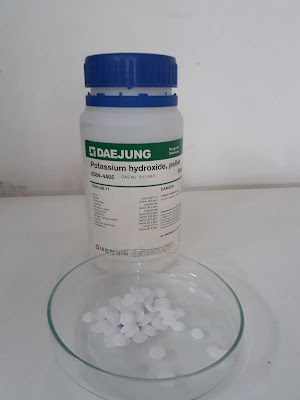Contents
hide
CHEMICAL PRODUCT IDENTIFICATION
- Product Namely: Potassium Hydroxide.
- Signal Sign: Danger!
- Read this – KOH SDS!
The manufacturing of soap, the creation of biofuels, & the treatment of water are only a few industrial & laboratory applications for the strong base potassium hydroxide (KOH). It is an extremely corrosive & caustic material that, when contacted, can lead to serious burns, eye irritation, skin damage, & respiratory system damage.
HAZARDS IDENTIFICATION
- Oral acute toxicity is a class of hazards.
- poisonous(harmful) if swallowed.
- Poisoning Act: Poisoning from consuming potassium hydroxide can result in symptoms like nausea, vomiting, diarrhea, & even death.
- Avoid eating, drinking, & smoking while utilizing this product.
- damage to the eyes & serious burns to the skin.
COMPOSITION, INFORMATION ON INGREDIENTS
- Component Name: Potassium hydroxide.
- CAS Number: 1310-58-3.
- Formula: KOH.
- Formula Weight: 56.11 g/mol.
FIRST-AID MEASURES
- If you feel unwell, contact a doctor.
- If inhaled: Remove the victim to fresh air & keep them at rest in a breathing-friendly position.
- If in the eyes: Carefully rinse for a few minutes(20 minutes) with water. If contact lenses are present & simply possible to remove, do so. Rinsing continues.
- If on the Skin: Use lots of water for washing.
- If Swallowed: Rinse your mouth. If you feel sick, make a doctor’s appointment.
- Wash contaminated clothes before reusing them.
- Don’t induce vomiting.
FIRE-FIGHTING MEASURES
- It appears as solid that doesn’t catch fire.
- Produces dangerous gases when heated.
- Use a tri-class dry chemical fire extinguisher in the event of a fire (Use carbon dioxide, foam, dry chemical, or water spray).
- Firefighters should dress in full protective gear & wear self-contained breathing apparatus.
ACCIDENTAL RELEASE MEASURES
- Prevent this solid from becoming airborne.
- Clean up, put in a sealed bag or container, & throw away (Dispose of).
- After the debris has been collected, ventilate the area & clean the spill site.
HANDLING & STORAGE
- Store alongside carbonates, oxides, silicates, & hydroxides.
- It has a tendency to absorb carbon dioxide & moisture from the air.
- Keep the container firmly shut & labelled.
- Store in a dry, cold area(place), away from heat sources, sparks, & open flames.
- Use only under a hood or in a room with good ventilation.
EXPOSURE CONTROLS, PERSONAL PROTECTION
- Wear appropriate eye protection, gloves, & clothes.
- After handling, carefully wash your hands.
- Use only under a hood or in a room with good ventilation.
- Engineering controls: Maintain potassium hydroxide dust or mist concentrations below the advised exposure limit by using proper ventilation.
- rules for exposure 2 mg/m3 as a maximum (ACGIH).
PHYSICAL & CHEMICAL PROPERTIES
- Appearance: It appears as white pellets or flakes.
- Odor: It is odorless.
- Boiling point: 1320°C.
- Melting point: 405°C (variations with water content)
- pH: Basic nature.
- Specific gravity: 2.044.
- Solubility: It is soluble in water, glycerol & alcohol.
- Water makes from 10% to 15% of the potassium hydroxide reagent.
STABILITY & REACTIVITY
- Avoid coming into contact with magnesium, copper, organic compounds, acid chlorides, & acid anhydrides.
- It has a fairly long shelf life; airborne carbon dioxide & water are absorbed.
- It is recommended to keep the container firmly shut while handling this product.
TOXICOLOGICAL INFORMATION
- Acute effects: It has corrosive nature to skin, eyes, & other tissues.
- Chronic effects: N/A.
- Target organs: It targets skin, eyes & respiratory system.
- LD50 for ORL-RAT: 1,230 mg/kg.
- LC50 for IHL-RAT: N/A.
- LD50 for SKN-RBT: N/A.
ECOLOGICAL INFORMATION
- Aquatic creatures are only mildly poisonous to potassium hydroxide. It dissociates in water & can cause the pH of poorly buffered systems to rise. It does not have any degradable functional groups, hence it has no need for biological oxygen.
DISPOSAL CONSIDERATIONS
- Dispose of in accordance with local, state, & federal rules or laws.
TRANSPORT INFORMATION
- Solid potassium hydroxide is its shipping name. Corrosive, class 8, is the risk(hazard). UN. number 1813.
REGULATORY INFORMATION
- RCRA codes D002, D003, & EINECS listing (215-181-3).
OTHER INFORMATION
This KOH SDS is intended as a piece of advice & is based on data & tests that are likely to be reliable. I don’t guarantee the data’s correctness or completeness & I’m not responsible for any resulting losses. The information is only being provided for your review, research, & verification. I DO NOT ASSUME RESPONSIBILITY AND EXPRESSLY DISCLAIM LIABILITY FOR LOSS, DAMAGE, OR EXPENSE RESULTING FROM OR IN ANY WAY CONNECTED WITH THE HANDLING, STORAGE, USE, OR DISPOSAL OF THIS PRODUCT FOR THE FOREGOING AND OTHER REASONS.
Click for: Thermo Fisher Scientific SDS

CONCLUSION
Upon contact, potassium hydroxide, a chemical that is extremely corrosive & caustic, can harm the eyes, skin, & respiratory system & cause serious burns, irritation, and damage. When dealing or interacting with potassium hydroxide, adequate safety measures, such as the use of personal protection equipment, suitable ventilation, & secure storage procedures, must be taken to avoid mishaps & injuries. In the event of unintentional exposure, first aid should be administered right away, so if symptoms persist, medical treatment should be sought. Additionally, when dealing with potassium hydroxide, it’s crucial to handle it carefully & wear safety equipment at all times & must follow KOH SDS.
